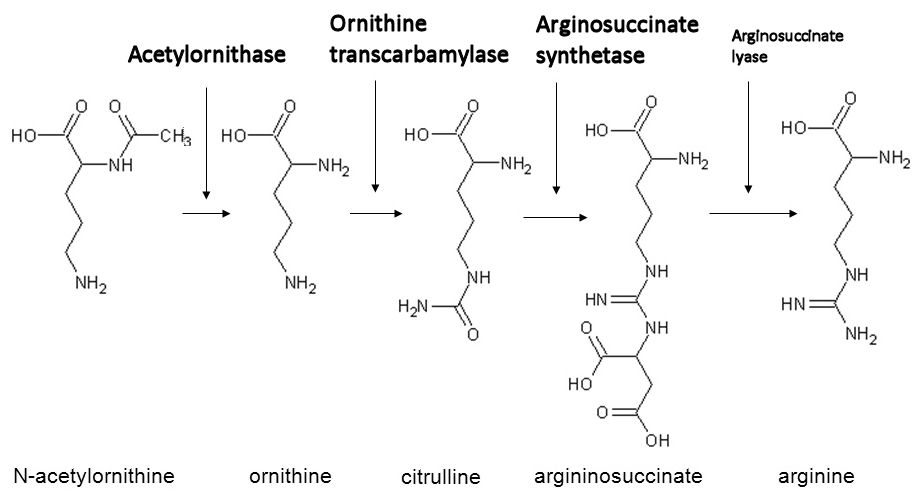
P: ot+ot+ as as X ot ot as+as+
F1: ot+ot as+as
| ot+as+ | ot+as |
ot as+ | ot as | |
| ot+as+ | Arg |
Arg | Arg | Arg |
| ot+as |
Arg | Cit |
Arg | Cit |
| ot as+ |
Arg | Arg | Orn |
Orn |
| ot as |
Arg | Cit |
Orn |
Orn |
Recessive Epistasis in a
diploid Arginine biosynthesis pathway
Beadle
& Tatum analyzed the genetics of Arginine
biosynthesis in the haploid bread mold Neurospora.
The same pathway occurs in diploid organisms:
genetic analysis of mutant alleles affecting metabolic
intermediates of Arginine production provides a
general model for the behavior of multiple gene loci in
a single pathway.
In diploid yeast (Saccharomyces), the precursor N-acetyl-ornithine is converted to Arginine in four steps catalyzed by four enzymes as shown. We designate the loci as AO, OT, AS, and AL, respectively. Wildtype auxotrophs are ao+ao+ ot+ot+ as+as+ al+al+. Pure-breeding lines of ot [ot ot as+as+ ] and as [ot+ot+ as as ] heterotrophs are unable to convert Ornithine to Citrulline, and Citrulline to Arginosuccinate, respectively. These two parental lines are crossed to produced heterotrophic F1 dihybrids [ot+ot as+as ], and two F1s are crossed, with phenotypes as shown. Any individuals with at least one ot+ and at least one as+ allele are auxotrophs able to synthesize Arginine. Any individual with an ot ot genotype accumulates Ornithine because Ornithine transcarbamylase is not produced. Any individual with an as as genotype accumulates Citrulline, except that ao ao ot ot genotypes instead accumulate Ornithine, the previous intermediate in the pathway, because the ao ao genotypes blocks the pathway prior to the production of Citrulline. That is, a recessive genotype at AO suppresses expression of a dominant genotype at the the next gene in the pathway, OT.
Homework: Predict and/or construct Punnet squares to show the consequences of dihybrid crosses involving the AO and AL loci and an ao+ao+ ot+ot+ as+as+ trihybrid cross, assuming complete dominance of the ao+ ot+ s+alleles.
Homework: Recall the growth / no-growth phenotypes of Neurospora are a consequence of synthesis or non-synthesis of Arginine. In the yeast example, note that the ot+- as+- genotypes produce Arginine and are thus auxotrophic, whereas both the ot ot and as as genotypes [grey boxes] fail to produce Arginine, and in consequence are heterotrophic. How does the resultant phenotypic ratios compare with other forms of epistatic interaction between loci?
In diploid yeast (Saccharomyces), the precursor N-acetyl-ornithine is converted to Arginine in four steps catalyzed by four enzymes as shown. We designate the loci as AO, OT, AS, and AL, respectively. Wildtype auxotrophs are ao+ao+ ot+ot+ as+as+ al+al+. Pure-breeding lines of ot [ot ot as+as+ ] and as [ot+ot+ as as ] heterotrophs are unable to convert Ornithine to Citrulline, and Citrulline to Arginosuccinate, respectively. These two parental lines are crossed to produced heterotrophic F1 dihybrids [ot+ot as+as ], and two F1s are crossed, with phenotypes as shown. Any individuals with at least one ot+ and at least one as+ allele are auxotrophs able to synthesize Arginine. Any individual with an ot ot genotype accumulates Ornithine because Ornithine transcarbamylase is not produced. Any individual with an as as genotype accumulates Citrulline, except that ao ao ot ot genotypes instead accumulate Ornithine, the previous intermediate in the pathway, because the ao ao genotypes blocks the pathway prior to the production of Citrulline. That is, a recessive genotype at AO suppresses expression of a dominant genotype at the the next gene in the pathway, OT.
Homework: Predict and/or construct Punnet squares to show the consequences of dihybrid crosses involving the AO and AL loci and an ao+ao+ ot+ot+ as+as+ trihybrid cross, assuming complete dominance of the ao+ ot+ s+alleles.
Homework: Recall the growth / no-growth phenotypes of Neurospora are a consequence of synthesis or non-synthesis of Arginine. In the yeast example, note that the ot+- as+- genotypes produce Arginine and are thus auxotrophic, whereas both the ot ot and as as genotypes [grey boxes] fail to produce Arginine, and in consequence are heterotrophic. How does the resultant phenotypic ratios compare with other forms of epistatic interaction between loci?